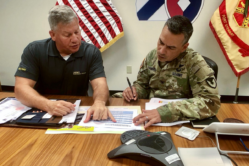The Military’s Savings Deposit Program (SDP) is one of the military’s best kept investing secrets. But don’t confuse the Savings Deposit Program (SDP) with the Thrift Savings Plan (TSP). TSP is available to everyone in the military. However, the Savings Deposit Program is available only to those serving in designated combat zones.
About the Military Savings Deposit Program (SDP)
The Military Savings Deposit Program (SDP) is a DoD sponsored savings account that offers deployed military members a guaranteed return on investment of 10% interest, compounded quarterly. The SDP was originally started during the Vietnam War as an investment opportunity for veterans serving in Southeast Asia. The program eventually went away, but it was resurrected during Desert Storm in 1991, then offered to troops in Bosnia in 1996. The program was expanded again in 1997, 2001, and 2003.
This is a great opportunity for those who put their life on the line every day, and one of the best ways to save money while deployed. There are several pros and cons to this program, so let’s take a look at how it works, then you can decide if this is a good investment opportunity for you.
How the Savings Deposit Program Works
Establishing SDP Eligibility
The DOD Savings Deposit Program (SDP) is only available to military members receiving Hostile Fire Pay for at least 30 consecutive days, or at least 1 day in 3 consecutive months. Once you have established eligibility for the SDP, you may begin making contributions, electing to withhold all or part of your paycheck (in $5 increments) to be deposited in the SDP.
SDP Contribution Limits
You may contribute up to $10,000 total, but you are limited to monthly contributions up to the amount of your base pay (officers are limited to contributions equal to the highest enlisted pay rate). Depending on how much you earn each month, it may take you several months to max out your SDP contributions.
Once your contributions are in place, they will begin earning 10% annual interest, which compounds quarterly. You can start and stop contributions at any time while eligible for the program, but it may take several days for the allotment request to take effect, so be careful with timing in regard to paydays.
Making Savings Deposit Program Withdrawals
Your contributions must remain in your SDP account until you return home from your deployment, except in certain cases due to hardships or limited other reasons.
You can leave your contributions and earnings in the SDP account indefinitely, but your funds will stop accruing interest 90 days after you redeploy from the combat zone. Withdrawals can only be made once your eligibility for the program has ended (usually redeploying or leaving the combat zone).
Here is more information about withdrawals from the Savings Deposit Program.
Pros and Cons of the DoD Savings Deposit Program (SDP)
Advantages of the Savings Deposit Program:
- 10% interest… Need I say more? It’s nearly impossible to find a guaranteed return on investment of 10%.
- 90 days of additional growth. You can earn interest on your SDP deposits for up to 90 days after you redeploy. An extra quarter of interest could be worth over $100.
Disadvantages of the Savings Deposit Program:
- Income is taxable. Interest earned in your Savings Deposit Program is taxable, even though your income while deployed is not taxable.
- Paperwork. You have to fill out forms to start the program and make withdrawals. The forms aren’t a big deal, but you have to take the time to go to your military finance office and find someone familiar with the program (many military members, including many in the finance office, are not aware this program exists).
- Messing with your military paycheck is never advisable. You must start and stop allotments each time you alter your contribution amount, and your military pay must be coordinated with the Savings Deposit Program. I know several people who experienced problems with this process and ended up waiting for a paycheck or two before their situation was resolved.
- It can take a while to max out your contributions. Junior enlisted members may not be able to max out the SDP plan because it would take several month’s worth of paychecks.
- Your contributions are tied up until you return home. You cannot make withdrawals until you return from the deployed combat zone.
It’s not all gloom and doom, however. Even though there are several listed disadvantages, the guaranteed 10% return on the interest is tough to beat.
Should You Invest in the Savings Deposit Program?
I won’t make the call for you, but I will let you know both my wife and I took advantage of the Savings Deposit Program while we were deployed. Based on some situations I have seen with the military pay system and the uniqueness of this program, I only recommend it if you have a well-established emergency fund in place, just in case anything goes awry and your pay is messed up for one or two checks.
This program also works best if you will be in the region long enough to max out your contributions or at least come close. Otherwise, you don’t gain many benefits. Finally, leave your deposits in for the full 90 days after you redeploy to take advantage of an additional quarter of compound growth.



Comments:
About the comments on this site:
These responses are not provided or commissioned by the bank advertiser. Responses have not been reviewed, approved or otherwise endorsed by the bank advertiser. It is not the bank advertiser’s responsibility to ensure all posts and/or questions are answered.
Lisa says
thank you so much for this helpful site! so much more info than dfas or any other mil.personnel can give! 2 quick questions on the SDP…i noticed you wrote that for officers, the cap they can contribute monthly is the base pay of the highest enlisted soldier. DFAS was clueless on this one when i called to inquire…so do you know how my husband would find out what his montly cap is since he is an officer? and one other question…does it matter if we deposit the funds quickly or throughout his year deployment? i know interest is compounded quarterly, but does it really matter if the interest is capped at 10% since we plan to maximize and deposit the full $10k? if i understand it right, the most he will get from interest is $1k no matter when he contributes to the plan.
Ryan Guina says
Hi Lisa,
Thanks for the compliments – it’s a pleasure running this site.
To answer your questions:
1) I believe the monthly cap for officer contributions is set at the monthly cap for an enlisted personnel (I’m assuming this is the E-9 base pay rate, but I couldn’t find the exact answer on the DoD Savings Deposit Program page.
2) Maxing out your contributions more quickly will help you earn more interest over the course of the year, but depending on how quickly you max it out, the difference shouldn’t be more than a few hundred dollars. It may be in your best interest to max it out more slowly if doing so would improve your cash flow (in other words, don’t try to max it out too quickly if it will cause financial problems or make things difficult in the present). The other thing to consider us that your husband can leave the money in his account for 90 days after he returns home, and it will continue earning interest during that time.
James says
I would not be so quick to assume that maxing your account to the 10k limit is the best move. It states in the fine-print that once the account hits the max (10,000 dollars) it will gain simple interest. Unable to find anyone with the right answers on how to maximize the program, and I have asked quite a few finance offices (yes, overseas ones). It is a good program never-the-less, but the Military shows its true colors on how they train people who have the finance MOS when you hear it works 20 different ways from 20 people, even OIC’s.